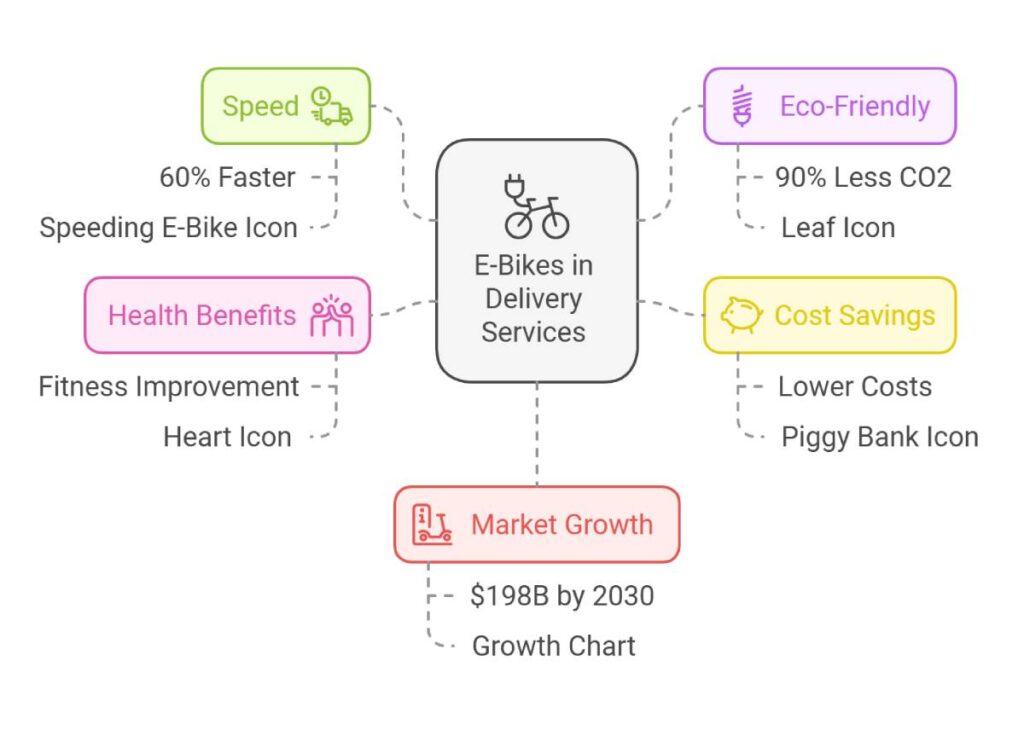Imagine a delivery system where packages zip through city streets swiftly while treading lightly on our planet. Welcome to the world of electric bikes (e-bikes) revolutionizing the delivery industry.
As urban areas grow busier and eco-consciousness rises, e-bikes emerge as the perfect solution for faster, greener, and more efficient deliveries.
Dive into our comprehensive guide to discover how these two-wheeled wonders are transforming logistics, benefiting businesses, and enhancing the well-being of delivery workers.
Whether you’re a business owner or an eco-enthusiast, e-bikes offer a compelling blend of speed and sustainability that’s hard to ignore.
Benefits of Electric Bikes for Delivery
Checking out what electric bikes (e-bikes) bring to delivery services can open up a world where deliveries are quicker and far kinder to our planet.
Faster Deliveries
Let’s talk speed because e-bikes aren’t just for leisurely rides in the park. Various tests from all over, places like New York, Belgium, and even Singapore, show e-bikes can hustle—messing up delivery time by being up to 60% quicker than regular four-wheelers.
| Delivery Type | Delivery Speed |
|---|---|
| Traditional Vehicles | Not so fast |
| E-Bikes | 60% Faster! |
This rush of speed doesn’t just make customers smile wider; it helps businesses stay a step ahead. E-bikes really shine when it comes to that crucial last-mile delivery. With folks wanting their packages faster by the minute, this speed boost will come in handy, especially with the demand for speedy last-mile delivery expected to skyrocket.
Reduced Carbon Footprint
Ever thought about how much pollution delivery vehicles burp out? E-bikes change the game by cutting down these emissions big time. Compared to diesel and even electric vans, they slash carbon dioxide levels sharply—90% less compared to diesel and about 33% less than their electric cousins.
| Vehicle Type | CO2 Emissions Reduction |
|---|---|
| Diesel Vans | 90% Less |
| Electric Vans | 33% Less |
This is huge in today’s world, where everyone’s thinking green. Deliveries are not just about getting stuff from A to B anymore; they’re about doing it responsibly. Use e-bikes, and you’re ticking the boxes for eco-friendly operations while keeping up with what increasingly eco-conscious folks expect.
For the lowdown on different e-bike types and how they fit into delivery, peek at our guide on ebike classifications. And if you’re wondering about keeping those e-bikes running smoothly, our piece on electric bike battery care is a must-read.
E-bikes bring a win-win: speed and eco-friendliness. They’re a modern must-have for delivery businesses wanting to be ahead of the curve. As everything shifts towards more sustainable practices, these perks become irresistibly compelling. For more juicy details on expenses and other benefits, check out our sections on ebike running costs and commercial ebike fleet.

Growth of E-Bikes in Delivery Industry
Integration into Delivery Fleets
You wouldn’t believe how electric bikes have rolled into the delivery game, turning heads and tipping scales! A whopping 100,000 e-cargo bikes made their way into European delivery fleets between 2018 and 2021. This shift shows how e-bikes offer a leg up in lowering those dreaded per-shipment costs and improving overall hustle flow.
Urban areas have taken a special liking to these battery-powered wonders. In the bustling streets of New York City, about 65,000 e-bikes are zipping around delivering everything from dumplings to documents. These little speedsters allow delivery peeps to crank out more orders, which means fatter paychecks and happier tummies.
On the money side of things, e-bikes do their job like champs. Deliveries get done quicker and with less stress, meaning folks can squeeze in more jobs every day. If you’re curious about the tech behind e-bikes, peek at our guide on mid drive vs hub motor ebike.
Increasing Demand for Last-Mile Delivery
Brace yourselves, the last-mile delivery demand is climbing faster than a cat up a tree—expecting a wild 78% bump by 2030. In this race to meet high demands, e-bikes are proving to be the tight-fitting solution logistics have been searching for.
E-bikes shine for those last-mile dashes thanks to their zippy nature and knack for dodging city snags like traffic jams. They’re like the street ninjas of urban delivery, easily slipping through clogged streets and parking wherever they fit. You don’t really have to worry about finding a spot when you’re on two skinny wheels. For a deeper dive into how e-bikes work magic in commutes, check out the ebike commuting guide.
What makes e-bikes so tempting these days? Here’s the scoop:
| Factor | Benefit |
|---|---|
| Operational Cost | Way cheaper than those bulky vans or cars |
| Environmental Impact | Your carbon footprint gets a neat trim |
| Speed | They just scoot through traffic like they’re in a video game |
| Flexibility | ‘Park’ in spots only a bike could |
E-bikes aren’t just for the speed-lovers; they’re a win-win for eco-sensitive people and penny-pinching companies alike. As cities get busier, expect to see more of these eco-friendly wheels whizzing about. For more on costs and why e-bikes make sense, swing by our ebike running costs.
With e-bikes weaving into fleets and dominating last-mile deliveries, they’re already leaving a big, green mark on logistics. Whether you’re on the delivery end or the receiving end rooting for Mother Earth, e-bikes are setting the stage for future transit. Curious about the big picture? Head over to our delivery ebike guide for the 411.
Environmental Impact of E-Bikes
Comparison to Traditional Vehicles
Electric bikes (e-bikes) are like the planet-saving heroes we’ve been waiting for, especially when pitted against traditional gas-guzzlers and even their electric counterparts. Doing their bit for the planet, e-bikes emit up to 90% less carbon dioxide than those smoke-belching diesel vans, and 33% less than electric vans.
That’s a huge sigh of relief for the planet, right? In this carbon-conscious era, those numbers aren’t just stats – they’re a head start in the race to squash carbon footprints.
| Vehicle Type | CO2 Emissions Reduction |
|---|---|
| Diesel Vans | 90% |
| Electric Vans | 33% |
Aside from acting as a carbon sidestepper, e-bikes have another ace up their sleeve by conserving battery resources. They’re no greedy guzzlers of lithium, cobalt, and graphite like those bulky electric cars. That means they’re a nimbler choice for last-mile delivery. We’re talking about a real chance to put the brakes on climate change—minus the buzzwords.
Reduced Traffic Congestion
Let’s sing praises for e-bikes’ ability to whisk through traffic jams like a knife through butter. Unlike those room-craving delivery vans, e-bikes deftly weave through urban jungles, making crowded streets a bit more breathable. Plus, fewer delivery vans means smoother rides for everyone—no matter how many wheels they’re sitting on.
And here’s the cherry on the cake: e-bikes double as noise ninjas that tone down the urban soundtrack. Their compact size and planet-friendly design make them a perfect match for the city’s heartbeat, turning down the volume on chaos while stepping up sustainability.
For an all-you-need-to-know scoop on e-bike goodness, take a gander at our ebike classifications guide.
Getting more e-bikes into those nifty delivery fleets means fewer headaches with traffic and cleaner skies. They’re the go-to for planet-caring city dwellers and on-the-dot deliveries everywhere. Curious about which motor might juice up your e-bike ride? Pop over to our breakdown on ebike motor types for all you need.
Market Trends in Micromobility
Global Market Size
The micromobility scene is really taking off, all thanks to the ever-growing frustration with high fuel prices, traffic jams, and the daily parking nightmare. Who’s happy about all this chaos? The micromobility market, which was worth a whopping $48.11 billion in 2021, is set to skyrocket beyond $198.03 billion by 2030, according to Movmi. This turbo-charged rise is mostly because people are jumping on shared electrics scooters and bikes, especially after COVID made us all rethink commuting.
| Year | Global Micromobility Market Size (US$ Billion) |
|---|---|
| 2021 | 48.11 |
| 2030 (Projected) | 198.03 |
Here’s something to think about: Inrix Research discovered that about 48% of car trips in the busiest U.S. cities are under three miles. Imagine zipping through streets on a cool electric bike or scooter, instead of getting stuck in traffic. Sounds appealing, right?
Take a peek at Metro Vancouver, where half the bikesharing fans slashed their car use. Just goes to show, that when it comes to personal vehicle cutback and ownership, sharing is caring!. Want more on how e-bikes stack up against regular bikes in this battle? Dive into our guide on e-bike vs regular bike.
Incentives for Environmentally Friendly Transport
It’s not just the numbers that are jazzing up the micromobility movement. Government perks are sweetening the deal to encourage eco-friendly travel. In the U.S., legislation like the e-bikes Act offers a tasty $1,500 credit for individual e-bikes and a cool $7,500 for electric cars (Movmi). This isn’t just about saving money; it’s about saving the planet, one e-bike ride at a time.
| Incentive | Credit Amount (US$) |
|---|---|
| Individual E-Bike | Up to 1,500 |
| Electric Car | Up to 7,500 |
With these incentives, leaping onto the eco-conscious bandwagon becomes a no-brainer for shoppers and city commuters. Electric bikes aren’t just reducing emissions—they’re paving the way for a greener world.
Thinking of delivery services? E-bikes might be the golden ticket. It’s worth comparing government incentives with savings on gas and maintenance costs. Dive into our commercial ebike fleet guide for the lowdown on e-bike delivery systems.
In the world of micromobility, understanding these trends and perks can be the key to making the most out of e-bikes. They’re not just an alternative; they’re your ticket to sustainable, nifty transport for both personal and business needs. Want in on some affordable e-bike gems? Our article on best cheap electric bikes has you covered.
Efficiency of E-Bikes vs Electric Cars
When you line up e-bikes against electric cars, the game is all about energy smarts and their part in the green revolution.
Energy Guzzle Showdown
E-bikes are like the Super Mario of energy savers. They clock in between 1000 to a whopping 4000 MPGe (yep, that’s miles per gallon equivalent), which leaves electric cars trailing far behind, with e-bikes being 20 to 35 times better in miles per kWh. That means e-bikes sip power like a fancy drink, going the distance with way less juice.
| Type of Ride | Efficiency (MPGe) |
|---|---|
| E-Bike | 1000 – 4000 |
| Electric Car | 100 – 141 |
Eco-Buddy Moves
E-bikes are like eco-superheroes in disguise. They zap emissions faster and cheaper than getting all cars switched to electric. Making them and running them needs way less earth-stuff and oomph.
Plus, e-bikes are champs at making the most out of battery goodies, using less of the fancy bits like lithium, cobalt, and graphite, compared to their electric car cousins. By hopping on e-bikes for your quick errands or deliveries, you shrink your carbon shadow and push for a cooler way to get around.
Want more scoop on how to pamper your e-bike? Check out our pages on electric bike battery care, how to charge ebike, and electric bike maintenance.
By being smart about how we move, folks in cities, eco-fans, and delivery peeps can steer us all towards greener streets. E-biking slashes emissions and makes sure we’re using our energy right. Curious about what motors make these e-bikes tick or which batteries give them the best kick? Dive into our tips on ebike motor types and find out about the best ebike batteries for the ultimate ride.
Cost Benefits of E-Bikes for Delivery
Initial Investment vs Car Costs
When you’re looking at opening your wallet, e-bikes won’t rob you blind like cars do. For a solid commuter e-bike, you’re spending somewhere between a grand and four grand. If you’re feeling fancy, a custom e-bike could set you back $10,000 to $12,000. Take the Momentum Voya E+ for example—it’ll cost you $2,800 in the US (Momentum Biking).
Now, let’s compare that to getting your hands on a car. You’re looking at $27,000 for a used one and a cool $47,000 for something fresh off the lot. With the dough for one used car, you could almost stack up ten brand new e-bikes.
| Type | Price Range |
|---|---|
| Basic Commuter E-Bike | $1,000 – $4,000 |
| Custom E-Bike | $10,000 – $12,000 |
| Used Car | $27,000 |
| New Car | $47,000 |
Want more help picking the perfect e-bike? Check out our ebike classifications page.
Recharging and Maintenance Costs
Plugging in an e-bike won’t drain your bank account like gas does. Take a Toyota Corolla Hatchback, which needs about $0.10 for every mile you drive. Meanwhile, pedaling with an e-bike like the Voya E+ will only set you back $0.04 a mile (unless you’re in Hawaii). A typical 32-mile round trip to work costs $3.20 in a car, but cruise on that e-bike and you’re just sipping $1.28 for the day.
| Type | Cost per Mile |
|---|---|
| Fuel-Efficient Car | $0.10 |
| E-Bike | $0.04 |
For tips on keeping your e-bike’s battery in tip-top shape, hit up our electric bike battery care guide.
When it comes to maintenance, e-bikes are the cheaper date. You’re looking at an average of $754 a year. That covers your tune-ups, new tires, and brakes, plus a battery replacement every couple of years. For cars, you’re shelling out about $1,186 annually, according to the American Automobile Association (AAA) back in 2017.
| Vehicle | Yearly Maintenance Cost |
|---|---|
| E-Bike | $754 |
| Car | $1,186 |
For more on looking after your e-bike, pop over to our electric bike maintenance page.
Parking costs? Hardly a worry with an e-bike. In the hustle and bustle of New York, you might be blowing $40 a day on parking, racking up to $345 a year once you factor in fuel and emissions as you hunt for a spot. E-bikes, on the other hand, let you park for free in most city bike areas—no extra cash needed.
For a deeper dive into costs, check our ebike running costs resource.
E-Bikes for Delivery Workers’ Health
Electric bikes aren’t just speedy delivery helpers; they’re secret superheroes when it comes to keeping delivery workers fit and healthy. Let’s take a closer look at how these nifty rides boost the bodies and minds of busy delivery folks.

Physical Exercise Benefits
Riding an e-bike is like getting a workout with a bit of a cheat code, where the electric motor lends a helping hand. Here’s what happens:
- Heart-Pumping Fun: E-biking gives your heart a workout, pumping up your heartbeat and boosting your fitness.
- Muscle Power: Pedaling helps tone up your legs, core, and back muscles, turning delivery riders into muscle machines.
- Burn That Fuel: It’s not just the battery that’s burning—riders can torch a good chunk of calories, which helps in keeping fit and trim.
| Health Metric | Average Improvement with E-Bike Use |
|---|---|
| Heart Rate | 50% increase during use |
| Calories Burned | ~450 calories/hour |
| Muscle Engagement | Legs, Core, Back |
Find out more about how e-bikes can sneakily give you a workout over in our post on ebike exercise perks.
Overall Well-Being Boost
But it’s not just about physical gains. E-bikes also bring peace of mind and improve the daily lives of delivery workers in various ways:
- Stress Buster: Riding feels good and helps melt away stress, which is vital for workers constantly racing against the clock and dodging city traffic.
- Nap Like a Pro: After a day on an e-bike, workers often enjoy deeper sleep, meaning they wake up refreshed and ready to roll.
- Happy Mind: Physical exertion releases those feel-good hormones, and endorphins. E-bikes help with keeping spirits high and anxiety low.
Hopping on an e-bike doesn’t just get packages from A to B; it’s a ticket to a healthier, more balanced lifestyle for the hard workers delivering your goods. Explore more about how e-bikes can enhance life for seniors and our ebike commuting know-how.
Bringing e-bikes into the delivery scene is a win-win, offering both practicality and well-being to today’s hustling couriers.
Choosing the Best E-Bike for Delivery
Picking the right e-bike for delivery jobs? It’s like finding the perfect pizza: you gotta get the right ingredients! Performance, reliability, and staying power are the foundational spices here. Nail those, and you’ll zip through deliveries like a breeze, all while keeping costs in check.
Motor Type Considerations
Motors are like the heartbeat of e-bikes. Three main contenders? Hub motors, mid-drive motors, and geared hub motors. Know the scoop on each, and you’ll snag a bike that’s just right for your gig.
| Motor Type | Characteristics | Use Case |
|---|---|---|
| Hub Motor | Lives in the wheel hub; simple design; low hassle | Best for flat roads; everyday jaunts; doesn’t break the bank |
| Mid-Drive Motor | Centrally located at the pedals; balances weight like a pro | Killer on hills; heavy hauls are a breeze; ace torque (mid drive vs hub motor ebike) |
| Geared Hub Motor | Boasts internal gears for extra kick; more compact than regular hub motors | Stop-and-go city driving; quick off the line; urban delivery superstar |
Check out Velotric’s Nomad 1—it’s got a beastly 750W motor that tackles demanding delivery routes without breaking a sweat.
Factors for Delivery Efficiency
An e-bike’s service game hinges on a few heavy hitters: battery life, weight, frame, and safety gadgets. Here’s what to keep an eye on:
Battery Life and Range: How far can it glide before a recharge? Picking a battery to match your delivery zone’s crucial. Longer battery life means less downtime and more cash in the bank. Dive into our ebike range factors for the lowdown.
Bike Weight: Lighter bikes are the dodgeball champs of maneuverability in the stop-and-go hustle of urban jungles—but must be robust enough to carry your stash.
Frame Type: This affects how smooth and tough the ride stays. Sturdy frames, whether aluminum or carbon, are your golden ticket—more from us on ebike frame materials.
Lighting & Safety Features: Can’t skip out on lights and safety bling like reflectors and horns—especially when the sun’s clocked out. More safety scoop over at ebike safety features.
| Factor | Importance | Example |
|---|---|---|
| Battery Life and Range | Cuts downtime; amps up working speed | Enduring batteries that juice up fast (how to charge ebike) |
| Bike Weight | Tweaks handling; a featherweight for city spins | Lightweight wonders for urban life; solid for carrying stuff |
| Frame Type | Handles wear and tear while keeping things comfy | Tough as nails aluminum or carbon fiber ebike frame materials |
| Lighting & Safety | Critical for low-lit rides; dodges accidents like a pro | Bright as day lights, reflectors, horns (ebike safety features) |
So there it is: evaluating motors, battery chops, weight class, frame strength, and safety doodads will guide you to the perfect e-bike catch. Make your delivery biz a breeze and grab more nuggets from our whiz-bang guides on electric bike power ratings and the best cheap electric bikes.
Conclusion
Electric bikes are not just a fleeting trend but a transformative force reshaping the delivery landscape. Their unmatched speed and eco-friendly profile make them indispensable for businesses aiming to enhance efficiency while committing to sustainability.
As urban congestion and environmental concerns escalate, e-bikes offer a practical solution that aligns with modern logistical demands and green initiatives. Moreover, the cost benefits—from lower initial investments to reduced maintenance expenses—make e-bikes a financially savvy choice for delivery fleets.
Beyond business advantages, e-bikes significantly improve the health and well-being of delivery workers, fostering a more vibrant and motivated workforce. The rapid growth of the micro mobility market underscores the increasing acceptance and integration of e-bikes in urban transport systems worldwide.
As government incentives continue to support eco-friendly transportation, adopting e-bikes becomes not just beneficial but essential for forward-thinking businesses. Embracing e-bikes today ensures a faster, greener, and more resilient delivery future, paving the way for sustainable urban living and efficient logistics.
FAQs
What are the main benefits of using e-bikes for delivery?
E-bikes offer faster delivery times, reduce carbon emissions, lower operational costs, and improve delivery workers’ health and well-being.
How much faster are e-bikes compared to traditional delivery vehicles?
E-bikes can be up to 60% faster than traditional four-wheelers, especially in last-mile delivery scenarios.
What is the environmental impact of switching to e-bikes for deliveries?
E-bikes reduce carbon dioxide emissions by 90% compared to diesel vans and 33% compared to electric vans, significantly lowering your carbon footprint.
Are there financial incentives for businesses to adopt e-bikes?
Yes, government incentives such as tax credits and rebates are available, and e-bikes have lower initial and maintenance costs compared to traditional vehicles.
What factors should be considered when choosing an e-bike for delivery?
Consider motor type, battery life, bike weight, frame durability, and safety features to ensure efficiency and reliability in delivery operations.
Final Thoughts
Electric bikes are more than just an alternative mode of transportation; they are a pivotal element in the future of sustainable urban logistics. By integrating e-bikes into delivery fleets, businesses can achieve remarkable improvements in speed and efficiency while significantly reducing their environmental impact.
The financial advantages, coupled with the health benefits for delivery workers, make e-bikes a compelling choice for forward-thinking companies. As urban populations continue to grow and the demand for swift, reliable deliveries escalates, e-bikes stand out as the optimal solution for last-mile delivery challenges.
Embracing this green technology not only aligns businesses with global sustainability goals but also caters to the increasing consumer preference for eco-friendly services. The continued expansion of the micromobility market and supportive government incentives further solidify the role of e-bikes in shaping a greener, more efficient delivery ecosystem.
Now is the time to invest in e-bikes and drive your delivery service into a sustainable and prosperous future.
Key Tips Around E-Bikes for Delivery
- Choose the Right Motor: Select between hub, mid-drive, or geared hub motors based on your delivery terrain and load requirements.
- Optimize Battery Life: Invest in high-capacity batteries and implement regular maintenance to ensure longevity and reliability.
- Lightweight Frames: Opt for lighter frames to enhance maneuverability without compromising durability.
- Safety First: Equip e-bikes with adequate lighting, reflectors, and safety gear to ensure secure deliveries day and night.
- Regular Maintenance: Schedule routine check-ups to keep e-bikes in top condition, preventing downtime and costly repairs.
- Leverage Technology: Utilize GPS and delivery management software to streamline routes and improve delivery efficiency.
- Employee Training: Train delivery workers on e-bike operation and maintenance to maximize performance and safety.
Recommended Biking Products and Accessories
- Momentum Voya E+
- Description: Reliable commuter e-bike perfect for urban deliveries.
- Price: $2,800
- Velotric Nomad 1 E-Bike
- Description: Powerful 750W motor e-bike ideal for demanding delivery routes.
- Price: $3,500
- Lumo Line Lights
- Description: High-visibility lighting system for enhanced safety during deliveries.
- Price: $120
- Bosch PowerPack Battery
- Description: Long-lasting battery to ensure extended delivery ranges.
- Price: $800
- Topeak Delivery Panniers
- Description: Durable and spacious panniers designed for carrying packages securely.
- Price: $150
- Garmin Edge 830 GPS
- Description: Advanced GPS device for optimizing delivery routes and tracking.
- Price: $400
- Schwalbe Marathon Plus Tires
- Description: Puncture-resistant tires ensure reliable performance on all routes.
- Price: $70 per pair
- Kryptonite New York Fahgettaboudit U-Lock
- Description: High-security U-lock to protect your e-bike from theft.
- Price: $150
- Bell K1 Urban MIPS Helmet
- Description: Lightweight, protective helmet with MIPS technology for safety.
- Price: $80
- PowerTap G5 Smart Trainer
- Description: Interactive smart trainer for indoor training and maintenance.
- Price: $1,200
These products and accessories are essential for optimizing your e-bike delivery operations, ensuring efficiency, safety, and reliability on every route.




